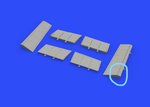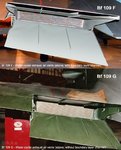Hi All,
I have been trying to find out a little about the shape of the Bf 109F wing flaps, but with little success. I've got the Squadron "In Action" book on the Bf 109 which does have some photos but none are clear and I've even visited the South African Museum of Military History which has a Bf 109F, but the top surface of the wing flaps is not visible.
My main question is this:
Was there a 'lip' along the flap which was visible when the flaps were extended and which fitted flush with the wing when retracted? Or was there no 'lip'? I've circled this in the attached picture.
Thanks for any help!
I have been trying to find out a little about the shape of the Bf 109F wing flaps, but with little success. I've got the Squadron "In Action" book on the Bf 109 which does have some photos but none are clear and I've even visited the South African Museum of Military History which has a Bf 109F, but the top surface of the wing flaps is not visible.
My main question is this:
Was there a 'lip' along the flap which was visible when the flaps were extended and which fitted flush with the wing when retracted? Or was there no 'lip'? I've circled this in the attached picture.
Thanks for any help!


